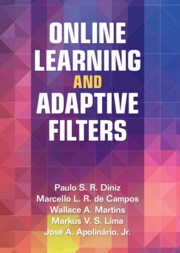Introduction
Published online by Cambridge University Press: 24 November 2022
Summary
It provides a brief description of the classical adaptive filtering algorithms, starting with defining the actual objective function each algorithm minimizes. It also includes a summary of the expected performance according to available results from the literature.
Information
- Type
- Chapter
- Information
- Online Learning and Adaptive Filters , pp. 1 - 15Publisher: Cambridge University PressPrint publication year: 2022
